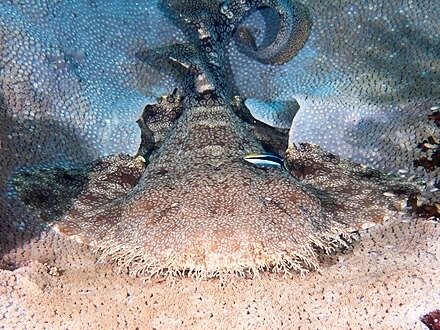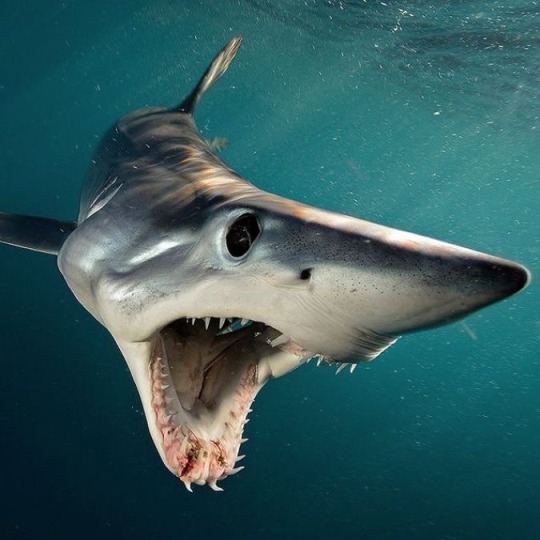Text

this odd little goober^^ is called a tasselled wobbegong and is 1 of 12 species of carpet shark in the orectolobidae family (wobbegong being the common name). orectolobidae are found in shallow, temperate and tropical waters of the western pacific ocean and eastern indian ocean, mainly around australia and indonesia. however, one, the japanese wobbegong, strays from this pattern by going as far as japan!
the 12 types of wobbegong are: tasselled, floral banded, gulf/banded, western, japanese, indonesian, spotted, ornate, dwarf spotted, network, northern and the cobbler wobbegong.
the reason for their classification as "carpet sharks" is of course related to their resemblance of ornately patterned carpets but also because they all have 5 gill slits, two spineless dorsal fins and a small mouth that doesn't extend past the eyes, as most of the species have barbels- small whiskerlike organs near the mouth which house taste buds and search for food in murky waters.
the tasselled wobbegong's arguably most distinctive trait is its fringe of branching dermal flaps around the head, which dribble onto its chin. the fringe enables the tasselled wobbegong to camouflage itself against the reef environment. this is done by the complex colour pattern of small blotches and reticulations (a pattern of interlacing lines resembling a net). their colour can actually change colour slowly over the course of several days to blend in with it's environment.
also, they're a nocturnal species and are only active at night. they're solitary snd spends most of the day resting in caves, under ledges, with their tail curled up around them. think of a really odd, kind of distorted and funny looking cat! similar, right? individual tasselled wobbegongs will have what's referred to as a small "home range". these areas contain several preferred resting spots which are used repeatedly.
wobbegongs primary diet is bottom-dwelling fish (mainly the bony type) and invertebrates such as small octopi, crabs or lobsters. when it hunts, they perch on reef and lunge up to suck in its prey. it then clamps down with its large jaw and fang-like teeth, not letting go until it's successfully killed its prey. the tasselled wobbegong is very opportunistic as it tends to remain in its favoured resting spot and whilst it's lounging, it'll ambush its prey. however, the little carpet also has its predators! this includes sharks- like the blacktip reef, horn, nurse, sand tiger and sand shark-, larger fishes and marine mammals.
these guys tend to reside in shallow habitats (ranging from 5 to 50 metres, 160 feet) near coral reefs! they're found in the tropical waters of the indo pacific ocean off of indonesia, australia and new guinea.
the maximum size of this species has been found to be 1 metre (4 feet) and it's complete lifespan is actually unknown but estimated to be about 26 years, between the average shark lifespan. this species has a very broad and flattened body and head, hence the carpet nickname.
we don't actually know much about the biological structure of the tasselled wobbegong but it's assumed to be a viviparous species (give birth to live young) based off of the reproductive habits of similar and related species. the pups are kept inside the womb of the female wobbegong in the form of eggs until they hatch and the young get their nourishment from the egg yolk. in a litter, there's typically 20 or more pups at a time. all measuring to about 20cm long (8 inches). their size at sexual maturity, however, is uncertain. their mating has been reported to have been observed in a cave at night, but not much else is known. one male, adult, was found to be adult at 1 metre - the average tasselled wobbegong size.
compared to other wobbegongs, the tasselled wobbegong is notorious for its "unprovoked attacks" on humans. whilst the species has certainly proved that it's capable of inflicting severe wounds, divers have also been able to approach the species without incident. given the sharks camouflaged appearance and poor vision, it's recommended people avoid accidentally harassing the shark as it will mistake a foot or hand as prey.
this carpet shark doesn't actually have a great economic value. although it's peculiar skin may occasionally be used for leather, it's not fished in australian waters and faces minimal threats. however, elsewhere, it may very well be affected by excessive fishery activity and habitat degradation (loss) from pollution, blast fishing (an illegal method involving explosives to stun/kill schools of fish) and coral removal. regarding this, the ICUN has declared this species of shark as least concern. meaning that it's still plentiful in the wild and isn't considered threatened or,pre 2001, conservation dependant.
note: ive came to the realisation that the previous image shown was a monkfish, not a tasseled wobbegong. i apologise for the misinformation! ive changed/updated the image since! very sorry
#shark#facts#fun facts#i love sharks#tasselled wobbegong#marine biology#marine life#ocean#special interest#science#biology#sea creatures#sea life#love to sea it#oceanposting#sharkblr#sharks
144 notes
·
View notes
Text

^^ this is a shortfin mako shark!! cute, right?
it belongs to the family of lamnidae, also known as mackerel sharks or isurids. lammidae are large, aggressive and powerful sharks that live in tropical to cold, temperate waters globally. there's only 5 species of shark belonging to this family: white shark, shortfin mako, longfin mako, porbeagle and the salmon shark.
its the fastest shark species with cruising speeds of 45mph (faster than a running horse!!) to astonishing speeds of 60mph! these gorgeous speed demons are able to be so magnificently agile due to their strong muscles and a streamlined body which allows them to power through water in fast bursts.
also, same as their lamnidae family, shortfin mako’s have specialised blood vessels that regulates their blood temperature to be higher than the surrounding water by producing heat metabolically. this is referred to as a heat exchange circulatory system and makes them one of the few endothermic sharks! their warms blood enhances their agility, allowing them to move at greater speeds, and being able to swim intensely for longer periods of time and reside in colder waters.
primarily, their diet consists of bluefish, swordfish, tuna, marine mammals and few other sharks. as they are aggressive predators near the top of the marine food web, this speedster doesn't have many predators, just commonly other larger sharks when shortfin's are still juveniles.
shortfin mako's habitat is near the surface of tropical and temperate oceans. juveniles are commonly located in coastal waters and adults are more likely found offshore. however, they are still highly migratory and are incredibly capable of swimming long distances across entire oceans!
these guys are certainly no where near being the largest shark species, the whale shark, by averaging size of 1-2 metres (6-7 feet). mako's suit the average shark lifespan (20-30 years) by being capable of living up to and over 30 years.
their reproduction doesn't happen until later in life. males at 8 years of age whilst females 20. a female shortfin shark's pregnancy lasts 15-18 months and they give birth to live young. their offspring ranges from 4-16 pups and, at birth, the pups range from 68-71cm (27-28 inches). also, each female will give birth to the ranged amount of pups every 3 years, due to their reproductive cycle. mating occurs from summer to autumn where eggs are fertilised internally and then develop inside the mother.
unfortunately, according to the 2019 stock assessment, shortfin mako sharks are overfished and subject to overfishing due to their coastal and temperate latitude across all oceans, making them an easy target. they are either targeted commercially, caught purposely to create a profit, or captured accidentally in fisheries. shortfins are valued for the quality of their fins and meat.
thankfully, NOAA fisheries implemented regulations to protect the shortfins after they were determined "critically endangered" in 2019, after being up-listed from "vulnerable" and "near-threatened" back in 2007. this rebuilding plan promotes population growth.
#shark#facts#fun facts#i love sharks#shortfin mako shark#marine biology#marine life#ocean#special interest#science#biology#sea creatures#sea life#love to sea it#oceanposting#sharkblr
66 notes
·
View notes